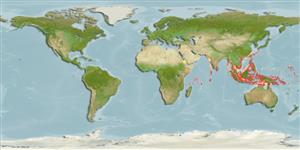>
Eupercaria/misc (Various families in series Eupercaria) >
Gerreidae (Mojarras)
Etymology: Gerres: Latin, gerres = a kind of anchovies; cited by Plinius.
More on author: Bloch.
Environment: milieu / climate zone / Mức độ sâu / distribution range
Sinh thái học
Biển; Thuộc về nước lợ Cùng sống ở rạn san hô; Ở đại duơng, biển (Ref. 51243); Mức độ sâu 1 - 40 m (Ref. 1602). Tropical; 26°C - 29°C (Ref. 4959); 30°N - 12°S
Indo-West Pacific: Madagascar to Australia. Reported from Vanuatu (Ref. 13300). Larvae reported in Japan as Gerres abbreviatus (Ref. 9902).
Bộ gần gũi / Khối lượng (Trọng lượng) / Age
Chín muồi sinh dục: Lm ? range ? - ? cm
Max length : 30.0 cm TL con đực/không giới tính; (Ref. 12915); common length : 25.0 cm SL con đực/không giới tính; (Ref. 37816)
Các tia vây lưng cứng (tổng cộng) : 9; Các vây lưng mềm (tổng cộng) : 10; Tia cứng vây hậu môn: 3; Tia mềm vây hậu môn: 7. Body silvery with indistinct fine dark stripes along scale rows above and 4-6 rows immediately below lateral line (apparent in newly preserved specimens; larger fishes). Body deep, depth max 1.9-2.3 in SL. Dorsal fin 2nd spine longer than 3rd; anal fin 2nd spine long and robust; caudal fin short and deeply forked; pectoral fins reaches beyond level of anal fin. No scales on upper preopercular flange in approximately 10 cm SL specimens; 1-5 scales (usually 2-3) in over 16 cm SL specimens. Scales between 5th dorsal fin spine base and lateral line 3.5-4.5 (Ref. 28029, 90102). Supraneural bones 3 (Ref. 41102). Ventral and anal fins yellow with white tips Ref. 34765).
Body shape (shape guide): short and / or deep; Cross section: compressed.
Marine species that enters estuaries and coastal lagoons in Madagascar (Ref. 4323). Forms schools on sandy bottoms (Ref. 12915, 48635). Small juveniles feed on zooplankton, larger fish feed on small polychaetes, bivalves, crustaceans and fishes (Ref. 3409). In Palau, spawners migrate from mangroves and sand flats to the outer reef edge around the full moon (Ref. 1602). Marketed fresh or made into fishballs (Ref. 12915).
Life cycle and mating behavior
Chín muồi sinh dục | Sự tái sinh sản | Đẻ trứng | Các trứng | Sự sinh sản | Ấu trùng
Iwatsuki, Y., S. Kimura and T. Yoshino, 1998. Redescription of Gerres erythrourus (Bloch, 1791), a senior synonym of G. abbreviatus Bleeker, 1850 (Teleostei: Perciformes: Gerreidae). Copeia 1998(1):165-172. (Ref. 28029)
IUCN Red List Status (Ref. 130435: Version 2025-1)
Threat to humans
Harmless
Human uses
Các nghề cá: buôn bán nhỏ
Các công cụ
Special reports
Download XML
Các nguồn internet
Estimates based on models
Preferred temperature (Tài liệu tham khảo
123201): 25.2 - 29.1, mean 28.5 °C (based on 694 cells).
Phylogenetic diversity index (Tài liệu tham khảo
82804): PD
50 = 0.5000 [Uniqueness, from 0.5 = low to 2.0 = high].
Bayesian length-weight: a=0.01202 (0.00895 - 0.01615), b=3.04 (2.99 - 3.09), in cm total length, based on LWR estimates for this species (Ref.
93245).
Mức dinh dưỡng (Tài liệu tham khảo
69278): 3.3 ±0.43 se; based on food items.
Thích nghi nhanh (Tài liệu tham khảo
120179): Chiêù cao, thời gian nhân đôi của chủng quần tối thiểu là dưới 15 tháng (Preliminary K or Fecundity.).
Fishing Vulnerability (Ref.
59153): Low vulnerability (20 of 100).
🛈
Nutrients (Ref.
124155): Calcium = 59.5 [25.4, 105.9] mg/100g; Iron = 0.557 [0.278, 1.092] mg/100g; Protein = 19.1 [17.1, 21.1] %; Omega3 = 0.119 [0.062, 0.210] g/100g; Selenium = 30.7 [15.8, 61.0] μg/100g; VitaminA = 45.3 [10.8, 175.0] μg/100g; Zinc = 1.29 [0.82, 1.91] mg/100g (wet weight);
